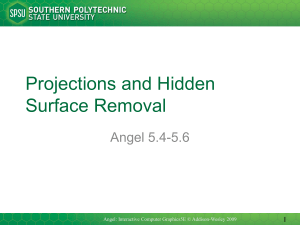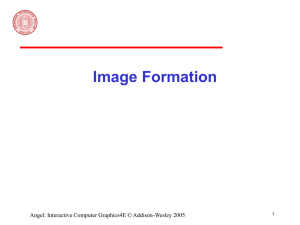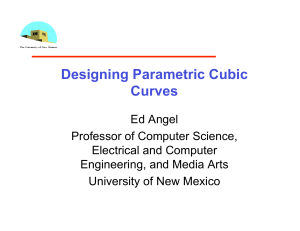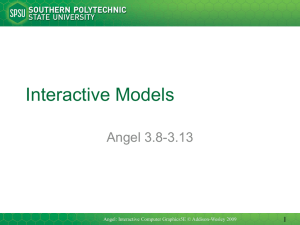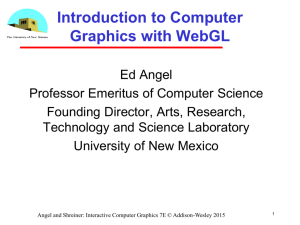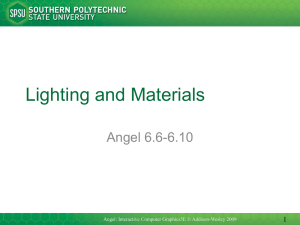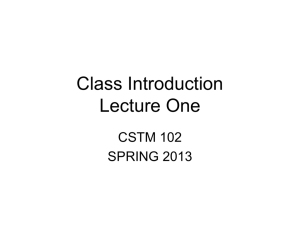Scientific Visualization Ed Angel Departments of Computer Science
advertisement
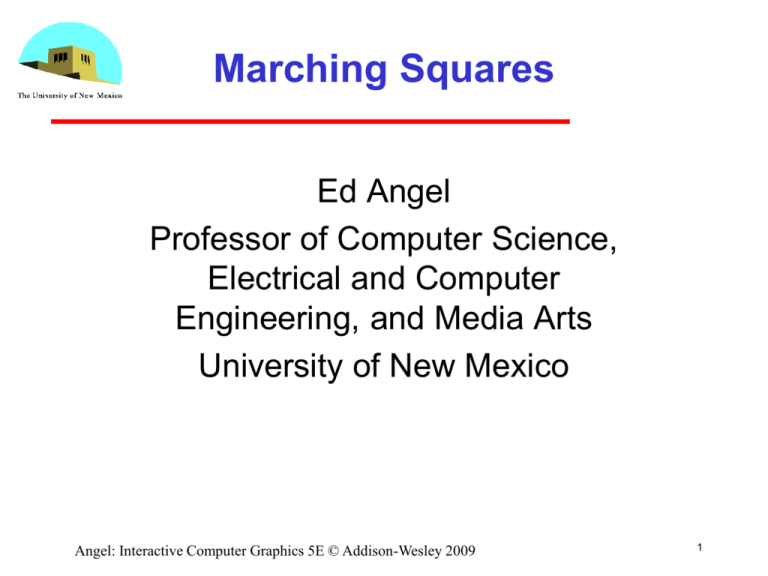
Marching Squares
Ed Angel
Professor of Computer Science,
Electrical and Computer
Engineering, and Media Arts
University of New Mexico
Angel: Interactive Computer Graphics 5E © Addison-Wesley 2009
1
Objectives
• Nontrivial two-dimensional application
• Important method for
- Contour plots
- Implicit function visualization
• Extends to important method for volume
visualization
• This lecture is optional
• Material not needed to continue to Chapter 3
Angel: Interactive Computer Graphics 5E © Addison-Wesley 2009
2
Displaying Implicit Functions
• Consider the implicit function
g(x,y)=0
• Given an x, we cannot in general find a
corresponding y
• Given an x and a y, we can test if they are
on the curve
Angel: Interactive Computer Graphics 5E © Addison-Wesley 2009
3
Height Fields and Contours
• In many applications, we have the heights
given by a function of the form z=f(x,y)
• To find all the points that have a given
height c, we have to solve the implicit
equation g(x,y)=f(x,y)-c=0
• Such a function determines the
isosurfaces or contours of f for the
isosurface value c
Angel: Interactive Computer Graphics 5E © Addison-Wesley 2009
4
Marching Squares
• Displays isocurves or contours for functions
f(x,y) = t
• Sample f(x,y) on a regular grid yielding samples
{fij(x,y)}
• These samples can be greater than, less than,
or equal to t
• Consider four samples fij(x,y), fi+1,j(x,y),
fi+1,j+1(x,y), fi,j+1(x,y)
• These samples correspond to the corners of a
cell
• Color the corners by whether than exceed or are
less than the contour value t
Angel: Interactive Computer Graphics 5E © Addison-Wesley 2009
5
Cells and Coloring
Angel: Interactive Computer Graphics 5E © Addison-Wesley 2009
6
Occum’s Razor
• Contour must intersect edge between a
black and white vertex an odd number of
times
• Pick simplest interpretation: one crossing
Angel: Interactive Computer Graphics 5E © Addison-Wesley 2009
7
16 Cases
Angel: Interactive Computer Graphics 5E © Addison-Wesley 2009
8
Unique Cases
• Taking out rotational and color swapping
symmetries leaves four unique cases
• First three have a simple interpretation
Angel: Interactive Computer Graphics 5E © Addison-Wesley 2009
9
Ambiguity Problem
• Diagonally opposite cases have two
equally simple possible interpretations
Angel: Interactive Computer Graphics 5E © Addison-Wesley 2009
10
Ambiguity Example
• Two different possibilities below
• More possibilities on next slide
Angel: Interactive Computer Graphics 5E © Addison-Wesley 2009
11
Ambiguity Problem
Angel: Interactive Computer Graphics 5E © Addison-Wesley 2009
12
Is Problem Resolvable?
• Problem is a sampling problem
- Not enough samples to know the local detail
- No solution in a mathematical sense without extra
information
• More of a problem with volume extension
(marching cubes) where selecting “wrong”
interpretation can leave a hole in a surface
• Multiple methods in literature to give better
appearance
- Supersampling
- Look at larger area before deciding
Angel: Interactive Computer Graphics 5E © Addison-Wesley 2009
13
Interpolating Edges
• We can compute where contour intersects
edge in multiple ways
- Halfway between vertics
- Interpolated based on difference between
contour value and value at vertices
Angel: Interactive Computer Graphics 5E © Addison-Wesley 2009
14
Example: Oval of Cassini
f(x,y)=(x2+y2+a2)2-4a2x2-b4
Depending on a and b we can have 0, 1, or 2 curves
midpoint intersections
interpolating intersections
Angel: Interactive Computer Graphics 5E © Addison-Wesley 2009
15
Contour Map
• Diamond Head,
Oahu Hawaii
• Shows contours
for many
contour values
Angel: Interactive Computer Graphics 5E © Addison-Wesley 2009
16
Marching Cubes
• Isosurface: solution of g(x,y,z)=c
• Same argument to derive method but use
cubic cell (8 vertices, 256 colorings)
• Standard method of volume visualization
• Suggested by Lorensen and Kline before
marching squares
Angel: Interactive Computer Graphics 5E © Addison-Wesley 2009
17

